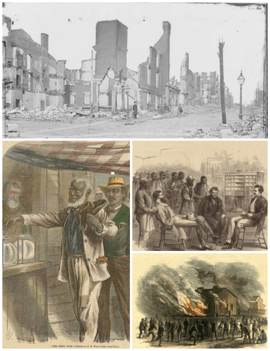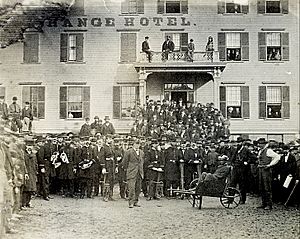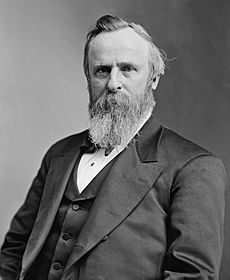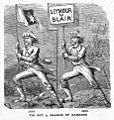Reconstruction of the United States facts for kids

The ruins of Richmond, Virginia after the American Civil War, newly freed African Americans voting for the first time in 1867, Office of the Freedmen's Bureau in Memphis, Tennessee, Memphis Riots of 1866
|
|
| Date | January 1, 1863 to March 31, 1877 (14 years, 2 months and 30 days) |
|---|---|
| Location | United States, Southern United States |
| Also known as | Reconstruction; Radical Reconstruction |
The Reconstruction Era was a special time in United States history right after the American Civil War. It lasted from 1865 to 1877. During this period, the country worked to rebuild the Southern United States after the war. The Southern states had lost their fight to leave the Union, and slavery was finally ended.
After President Abraham Lincoln was killed in 1865, Andrew Johnson became president. He wanted to quickly bring the Southern states back into the country. He allowed them to hold elections soon after the war ended. However, many former leaders of the Southern rebellion were elected to Congress. These states also passed laws that took away rights from formerly enslaved people.
Many members of the Republican Party in Congress wanted stricter rules for the South. After winning many seats in the 1866 elections, Republicans stopped former rebel leaders from joining Congress. They also passed laws that said these leaders could not hold office or vote. Three new changes, called amendments, were added to the U.S. Constitution. These amendments ended slavery, made formerly enslaved people citizens, and gave them the right to vote. Some Black people who had been enslaved even won elections and held public office.
Many white people in the South did not like the idea of Black people having equal rights or voting. Groups like the Ku Klux Klan formed to stop Black people from gaining political and economic power. After Reconstruction ended in 1877, white Southerners regained control. They passed Jim Crow laws, which kept Black and white people separate (segregation). These laws also took away the right to vote from many African Americans whose parents or grandparents had been slaves. For about 80 years after Reconstruction, white Southerners mostly voted against the Republican Party.
Contents
Understanding the Reconstruction Period
The Reconstruction period usually starts with the Emancipation Proclamation in 1863. It ends in 1877 when the last federal troops left the Southern states. Some historians think it lasted longer, even until 1890. This was when a bill to protect voting rights in the South failed to pass.
Why Reconstruction Happened
During the American Civil War, eleven Southern states that allowed slavery decided to leave the United States. They formed the Confederate States of America. President Lincoln said their actions were "legally void." After the Confederates attacked Fort Sumter, Lincoln raised an army to bring the Southern states back.
The war lasted four years, with many battles. The Confederate States were defeated in 1865. During the war, Lincoln issued the Emancipation Proclamation. This important document declared that all enslaved people in Confederate areas were "forever free."
Key Events Timeline
- August 6, 1861: The Confiscation Act of 1861 becomes law.
- March 3, 1862: Lincoln names Andrew Johnson as the first military governor of a Southern state.
- July 17, 1862: The Confiscation Act of 1862 becomes law.
- January 1, 1863: Lincoln issues the Emancipation Proclamation, freeing enslaved people in Confederate areas.
- December 8, 1863: Lincoln shares his "ten percent plan" for Southern states to rejoin the Union.
- January 16, 1865: General William Tecumseh Sherman issues Special Field Orders No. 15.
- March 3, 1865: The Freedmen's Bureau Act becomes law.
- April 9, 1865: General Robert E. Lee surrenders, ending the war.
- April 14, 1865: Lincoln is killed. Andrew Johnson becomes President.
- December 6, 1865: The Thirteenth Amendment to the United States Constitution is approved, ending slavery.
- March 27, 1866: Johnson vetoes the Civil Rights Act of 1866.
- May 1 to 3, 1866: Violent events in Memphis, Tennessee, kill many African Americans.
- July 24, 1866: Tennessee is the first Southern state to rejoin the Union.
- July 30, 1866: Many people are killed and wounded in New Orleans during a convention.
- October 9 through November 6, 1866: Congressional elections give Republicans a large majority.
- March 4, 1867: Congress passes the first Reconstruction Act, setting rules for states to rejoin.
- July 19, 1867: Congress passes the third Reconstruction Act, creating military rule in the South.
- March 2 and 3, 1868: Congress tries to remove President Johnson from office.
- May 26, 1868: The Senate votes against removing Johnson.
- July 9, 1868: The Fourteenth Amendment to the United States Constitution is approved, making former slaves citizens.
- February 3, 1870: The Fifteenth Amendment to the United States Constitution is approved, giving Black men the right to vote.
- May 31, 1870: The Enforcement Act of 1870 becomes law.
- February 24, 1871: Georgia, the last Confederate state, rejoins Congress.
- April 20, 1871: The Ku Klux Klan Act becomes law.
- May 22, 1872: The Amnesty Act becomes law.
- March 1, 1875: The Civil Rights Act of 1875 becomes law.
- November 6, 1876: The presidential election between Hayes and Tilden has a dispute over votes.
Major Changes During Reconstruction
The Emancipation Proclamation
In 1862, President Lincoln realized that ending slavery was important to win the Civil War. He wrote a first draft of the Emancipation Proclamation. This document would free enslaved people in states that were rebelling. After a Union victory at the Battle of Antietam, Lincoln released a first version. He gave the Southern states 100 days to return to the Union. If they didn't, the full proclamation would be issued.
On January 1, 1863, the Emancipation Proclamation was officially released. It named ten states where enslaved people would be "forever free." It did not include states that had stayed loyal to the Union. As the U.S. Army moved into the South, millions of enslaved people gained their freedom. Many of these newly freed people joined the U.S. Army and fought against the Confederates.
Lincoln's Plan for Rejoining the Union
President Lincoln wanted to quickly bring the Southern states back into the Union. In 1863, he suggested a plan for Louisiana, a captured Confederate state. His plan offered forgiveness to rebels who promised loyalty to the Union. It also said that only 10% of a state's voters needed to take this loyalty oath for the state to rejoin Congress. The state also had to end slavery in its new constitution.
Similar plans were made for Arkansas and Tennessee. By 1864, Louisiana had followed Lincoln's plan and sent representatives to Washington. However, Congress refused to accept these representatives. Congress, controlled by Republicans who wanted more changes, proposed a different plan. This plan required most of a state's voters to take the loyalty oath. Lincoln disagreed with this plan, showing a growing difference between him and the Republicans in Congress.
Legalizing Marriages for Formerly Enslaved People
Before 1864, marriages between enslaved people were not legally recognized. When they became free, many wanted to make their unions official. Before freedom, enslaved people could not sign contracts, including marriage contracts. Legal marriage helped the state recognize freed people as full citizens. It also helped protect parents' rights to their children. Before this, some Black children were taken from their families and used as unpaid workers.
The Freedmen's Bureau
On March 3, 1865, the Freedmen's Bureau Bill became law. Republicans supported it to help newly freed people and white refugees. This federal office provided food, clothing, and advice on work agreements. It tried to create fair relationships between freed people and their former owners. The Bureau could also rent out land for three years and sell it in small pieces.
With the Bureau's help, newly freed people began to vote and form political groups. This started a shift in power in the South. For example, in the 1868 presidential election, almost 700,000 Black voters helped Ulysses S. Grant win. However, the Freedmen's Bureau faced challenges. Groups like the Ku Klux Klan used violence to stop freed people from voting, holding office, or owning land.
Ending Discrimination
Other laws were passed to give more equal rights to African Americans. Lincoln made it illegal to discriminate based on race when carrying U.S. mail. He also ended discrimination on public streetcars in Washington, D.C., and made sure Black soldiers were paid fairly.
Important Constitutional Amendments
Three important changes were added to the U.S. Constitution during Reconstruction. They are known as the Reconstruction amendments.
- The Thirteenth Amendment, approved in 1865, officially ended slavery.
- The Fourteenth Amendment, approved in 1868, said that everyone born or naturalized in the U.S. was a citizen. It also gave them federal civil rights.
- The Fifteenth Amendment, approved in 1870, stated that the right to vote could not be denied because of "race, color, or previous condition of servitude" (meaning if someone had been a slave).
These amendments aimed to end slavery and give full citizenship to freed people. Many Black men actively participated in voting and political life. They also quickly built churches and community groups. After Reconstruction, white Democrats and other groups used force to regain power in Southern states. They passed laws that stopped most Black people and many poor white people from voting. This continued until the 1960s, when new laws were passed as a result of the Civil Rights Movement.
Enforcement Acts (1870–1871)
During President Ulysses S. Grant's time in office, Congress passed three strong civil rights laws called the Enforcement Acts. These laws aimed to protect Black people and the Reconstruction governments. They made it a crime to stop freed people from voting, holding office, serving on juries, or receiving equal protection under the law. The most important of these was the Ku Klux Klan Act, passed in 1871. This law allowed the president to use military rule and suspend certain legal rights to stop the Klan's violence.
Civil Rights Act of 1875
The Civil Rights Act of 1875 was one of the last major laws to protect equality for African Americans during Reconstruction. President Grant signed it into law in 1875. This law made it illegal to discriminate against Black people in public places like schools and transportation. Although it was hard to enforce, it worried white people who opposed racial equality. The Supreme Court later overturned it in 1883. Many parts of this law were later included in the Civil Rights Act of 1964.
Federal Troops Leave the South
After becoming president on March 4, 1877, Rutherford B. Hayes removed federal troops from Louisiana and South Carolina. These were the last states with Reconstruction governments. This allowed Southern Democrats, called "Redeemers," to take full control of these states. President Grant had already removed troops from Florida. By 1879, thousands of African Americans, known as "Exodusters", moved to Kansas for new chances.
Democrats gained control of Congress. President Hayes tried to stop them from overturning the Republican Enforcement Acts. However, with less money for the military, Hayes could not fully enforce these laws. African Americans still took part in Southern politics, especially in Virginia. In the late 1800s, some states even elected Black U.S. congressmen. But by the 1890s, new state constitutions in the South took away voting rights from most Black people.
Images for kids
-
Abraham Lincoln, 16th President of the United States (1861–1865).
-
Andrew Johnson, 17th President of the United States (1865–1869).
-
A poster from 1866 about the Freedmen's Bureau.
-
"This is a white man's government", a cartoon by Thomas Nast about the forces against Grant and Reconstruction in 1868.
-
Ulysses S. Grant, 18th President of the United States (1869–1877).
-
Eastman Johnson's 1863 painting The Lord is My Shepherd, showing a man reading the Bible.
-
Atlanta's rail yard and roundhouse in ruins after the Civil War.
-
Winslow Homer's 1876 painting A Visit from the Old Mistress.
-
A Republican Form of Government and No Domestic Violence, by Thomas Nast, a political cartoon from 1875.
See also
 In Spanish: Reconstrucción (Estados Unidos) para niños
In Spanish: Reconstrucción (Estados Unidos) para niños



















